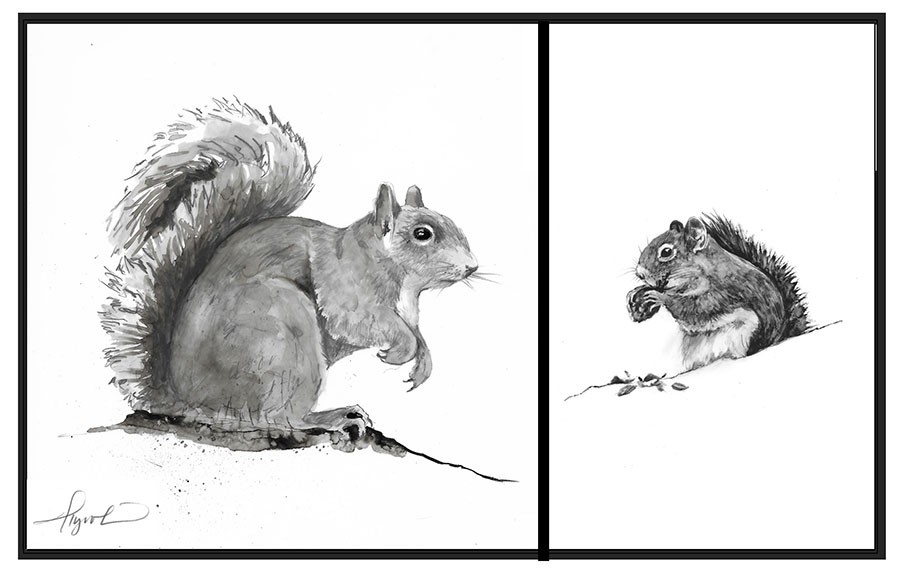
On winter mornings when I look out my window, I often see a gray squirrel clinging upside down to the post supporting my bird feeder, with his front paws in the tray, munching sunflower seeds. Sometimes, a much smaller red squirrel is perched on the opposite side of the feeder.
This brings to mind my studies of squirrels years ago and the differences between the two species. For my thesis in biology at Williams College, I conducted a field study of social behavior and organization in the eastern gray squirrel in a suburban area in Williamstown, Massachusetts. My first step was to live-trap and mark squirrels so I could identify individuals. Using peanut butter as bait, I captured 34 gray squirrels, weighed them (inside the trap), and checked underneath for their sex. To mark them, I attached the live-trap to a wire cone. Once the squirrel was in the cone, I dabbed a spot of black hair dye in a different location on each squirrel and assigned a number to it. After this quick procedure, I released them.
That fall and winter, I spent many hours wandering around my study area with binoculars, a notebook, and a chart of squirrel markings, looking for “my squirrels,” often eliciting odd looks from other students. I observed 500 social interactions between gray squirrels. The majority of these interactions were not aggressive – feeding or resting in close proximity, social grooming, and play. Aggressive behavior like chasing was observed mostly between resident squirrels and transient squirrels, between males competing for females during the winter breeding period, or during contests for food at a bird feeder. There was a high degree of tolerance and association among gray squirrels, a finding confirmed by other researchers. I often observed several squirrels feeding peacefully on maple seeds or apples in the same tree. Five squirrels (probably a mother, her two spring-born young, and her two summer-born young) shared a den cavity in a big silver maple. Once, I saw three of them gathering leaves and following each other up the tree to line their den hole. This tree was conveniently located outside the house I lived in, so I could observe the squirrels from my window when they emerged at daybreak while I sat in a comfortable chair sipping tea.
Some researchers have observed a dominance hierarchy among gray squirrels based on sex and age, though these studies were conducted at artificial feeders – a concentrated food source. I did not discover clear evidence of a pecking order and concluded that it may only function in times of food scarcity.
I plotted my sightings of each squirrel on a map and discovered that the home ranges overlapped considerably, a finding consistent with other studies. Gray squirrels are not territorial; they do not exclude others from their home ranges, though nursing females will defend den trees.
I also recorded interactions between gray squirrels and red squirrels. Half of these encounters were aggressive, and in most of these, the smaller red squirrel initiated the conflict. Red squirrels also chattered a warning when a gray squirrel entered the vicinity. In contrast to the sociable gray squirrel, red squirrels are territorial in their preferred habitat – pure coniferous forest – and vigorously defend forest patches from other squirrels.
The difference in social behavior between the two species likely stems from a difference in feeding habits. The buds, leaves, fruit, and seeds of deciduous trees, all favorite foods of the gray squirrel, are normally abundant from spring through fall, though they change as tree species flower and fruit at different times. The amount of mast fluctuates from year to year, and it’s an advantage for gray squirrels to be able to travel around their home ranges to forage without interference from other squirrels. During winter, gray squirrels usually rely on cached nuts, which they hide from other squirrels by burying them individually in scattered locations.
Red squirrels prefer the small seeds of conifers like spruce and fir, which they remove by turning the cones in their front paws and chewing off the scales, much like we eat corn on the cob. They store large piles of cones so the seeds will be available year-round, and so they must defend this larder and the trees they harvest the cones from.
Of course feeding habits and social behavior can change when humans tip the scales, which brings us back to the gray and red squirrels feeding within a foot of each other at my feeder, something not usually seen in nature.


Discussion *